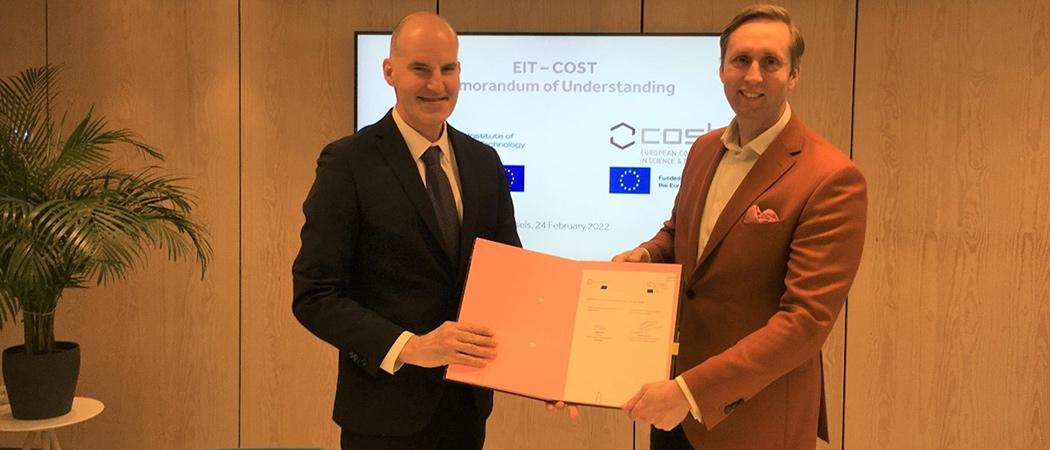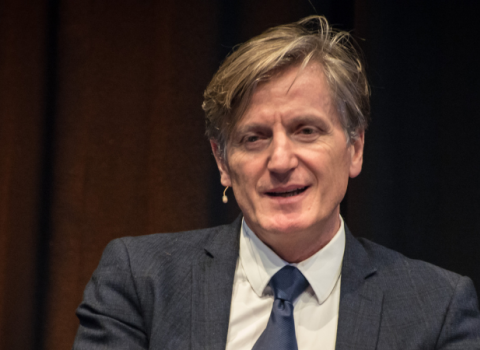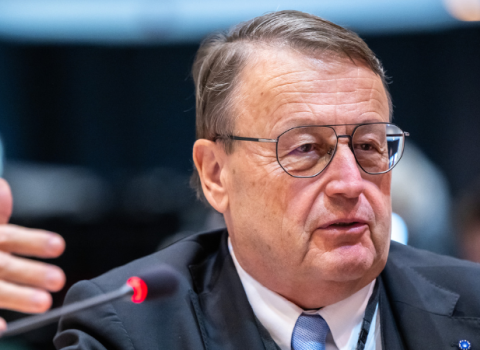COST and the European Institute of Innovation and Technology want their grantees in less innovative regions to benefit from a wider range of support

Martin Kern, EIT Director (left) and Ronald de Bruin, director of COST (right). Photo: www.cost.eu
The researcher networking association, COST and the European Institute of Innovation and Technology (EIT), are teaming up to provide training and funding services to innovators in central and eastern Europe.
The idea is to help innovators take advantage of the services the two Horizon Europe-funded institutions have to offer, providing fuller support for turning ideas into businesses.
“The whole idea behind this memorandum of understanding is to be more structured and a bit more pragmatic,” said Ronald de Bruin, director of COST. “We’re not making a declaration that we will solve the widening gap, but give it a bit more focus.”
For the EIT, the new partnership is a chance to further boost its renewed commitment to pay more attention to less innovative European regions, providing up and coming entrepreneurs training, business acceleration and funding services.
The EIT has networks in 18 countries in less innovative regions, and it hopes the innovators in these networks will now be able to link up to COST services in a more structured way.
COST, which funds more than 45,000 researchers to network and go on exchanges, hopes to become the networking platform in the future European Research Area, and building bridges with other parts of Horizon Europe is a key part of it.
The first order of business is bridging a pathway for COST grantees to take advantage of the EIT Jumpstarter programme, which helps innovators and entrepreneurs turn ideas into viable business models.
COST mostly funds researchers but it offers its grantees a one-year top-up Innovator grant which lets them explore the innovation potential of their research. With the extra help, “they are better positioned to obtain capital or to be in a better position for follow up funding for a business plan,” said de Bruin. Under the new partnership, COST hopes the researchers can go on to get help from the EIT to get these ideas to the market.
Future plans
The Jumpstarter will be the first of the EIT programmes to extend to COST researchers, but it will likely not be the last. The EIT has new projects in the pipeline such as helping universities innovate and contributing to the European Commission’s push for green architecture under the New European Bauhaus. “We feel there are a lot of opportunities to strengthen this cooperation rather than each programme working individually,” said Martin Kern, director of the EIT.
Kern hopes together with COST, the EIT can also help innovators in Ukraine once the war ends and the country starts rebuilding.
The cooperation agreement was drafted earlier in the year, before Russia invaded Ukraine, but Kern expects the country may become one of the focus areas for the new partnership. “Now, there is a strong commitment to support and rebuild innovation ecosystems in Ukraine,” he said.
Since the beginning of the Russian invasion, Ukraine has moved to join COST, becoming its 40th member state. Georgia, another country that has suffered from Russian aggression in recent years, joined at the same time.
At EU level, the new partnership follows the European Commission’s push for synergies within the Horizon Europe research programme. This is not the EIT’s first cooperation agreement in the past months. It’s already linked up its programmes with the European Innovation Council, an EU programme that supports innovators, mostly with funding.
“The idea is simply to have complementarity between the programmes that feed into the same objective to increase Europe’s innovation capacity,” said Kern. “If you have instruments such that we have with the EIC fast track, those innovators don’t have to start from scratch.”
This way, funding support from one programme at an early stage can be complemented with training from another institution and funding at a later stage, taking ideas to the market.
The first Horizon grantees are already said to benefit from linked up support. Lithuanian health start-up Ligence, which was part of the EIT’s accelerator programme for early-stage healthcare start-ups from central, eastern and southern Europe, recently secured support from the EIC for its AI-driven cardiac ultrasound analysis technology. “There are many such examples,” said Kern.





 A unique international forum for public research organisations and companies to connect their external engagement with strategic interests around their R&D system.
A unique international forum for public research organisations and companies to connect their external engagement with strategic interests around their R&D system.